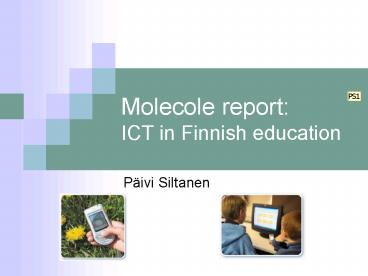Molecole report: ICT in Finnish education - PowerPoint PPT Presentation
1 / 11
Title:
Molecole report: ICT in Finnish education
Description:
The gap between the public rhetoric and school reality is criticized by the teachers. ... Comenius 2.2 Course in Lapland, Finland ... – PowerPoint PPT presentation
Number of Views:38
Avg rating:3.0/5.0
Title: Molecole report: ICT in Finnish education
1
Molecole reportICT in Finnish education
- Päivi Siltanen
2
1. Situation in Finnish schools
- The importance of the use of ICT in education is
widely recognized, but their application hasnt
advanced as expected. - The gap between the public rhetoric and school
reality is criticized by the teachers. - Realistic stand on ICT in education is needed,
because excessive expectations will only hinder
the implementation. - Sufficient equipment and technical support are
crucial, but do not alone guarantee meaningful
pedagogical exploitation of ICT. - There are two viewpoints on the slow propagation
of ICT - individuals and organizations need time for
learning how to use it - actual change would require adjustments in school
structures and present teacher-based practices
3
Teachers perceptions
- Teachers negative attitudes and lack of know how
are the most common explanation for the low
implementation of ICT - pupils often have better computing skills than
their teacher - teachers needs to develop their skills do not
get enough attention, and there are various
problems with the training - While admitting the possibilities of ICT in
education, teachers attitudes are realistic or
even critical - did not see ICT applicable on their subject or
educational aims - emphasized the balance between methods and
equipment - Lack of skills often makes teachers feel
incapable - demand too much from themselves, are discouraged
even by small obstacles - many fear, that their inadequate skills will
damage pupils learning process - A positive atmosphere in the school, an
encouraging headmaster and interested pupils have
a positive effect on teachers attitudes
4
2. Learning scenarios
Coomey and Stephenson (2002)
5
L ? a new equation of learning
In the future, we expect to have a new equation
of learning, which can be expressed as
follows L f ( V, H, M, W) where L
Learning V Virtual H Hypermediatic M
Mobile W Wireless This means that Learning
will be more and more Virtual, Hypermediatic,
Mobile and Wireless, as well as more diversified
and adapted to very different social situations.
(EU 2003)
6
3. Definition of key concepts
- Distance learning
- interaction between the parties of a learning
process through one or more medias - electronic
media is not required - E-learning
- the delivery of educational material through the
Internet by using the tools given online - Mobile learning
- one can study wherever he wants
- a mobile phone is used as a tool to communicate
7
4. Moments meta model
- A multidisciplinary conceptual frame and a
planning and evaluating model for network
learning - Developed as a part of Life as learning research
project funded by the Academy of Finland - Aimed to increase the best practices of network
learning and mobile solutions in teaching by
combining aspects from several disciplines
8
5. Using ICT in teaching
- Computer can be used as a mean or a tool in class
room learning. - Basic types of computer-based learning are
process learning, simulation learning, hypermedia
learning and tool learning. - Virtual school an institute that can be reached
via networks - Genuine interaction requires that learning
situation is two-way and based on dialog . - Interactive multimedia content
- should be used to obtain higher learning results
- should be developed in a content orientated way
using hardware, programming language and Internet
tools suitable for the purpose - In addition to professional competence a good
e-teacher has to meet certain personal
attributes, e.g. be able to meet emotions. - Both synchronous and asynchronous interaction can
be used. - There are several common platforms, e.g. WebCT
and PEDA.NET.
9
6. Challenges and possibilities
- Team organized schools and open learning
environments require adjustments in school
premises as well - functional room solutions, adequate equipment
etc. - Networking in key position Internet, intranet,
social networks etc. - unforeseen opportunities to utilize different
persons expertise - independence on time and place
- Bidirectional evaluation helps to improve the
quality of teaching. - As independent studying increases, teachers as
well as co-learners acquire a complex role of an
e-tutor - Using WAP in mLearning gives many possibilities,
but has also limitations (esp. related to
devices) and challenges in eg. usability. - Both teachers and learners roles are changing
with the implementation of new technologies.
10
Mobile learning is a new way for co-operative
learning.
11
(No Transcript)































